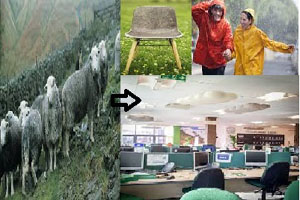
British wool industry bouncing back as innovators started creating variety of products
YarnsandFibers News Bureau 2015-09-20 14:00:00 – LondonBritain’s wool industry, which for a decade was shrinking is bouncing back as a series of innovations have sprung up, creating products that use wool from all 120 breeds of British sheep – around 60 pure and 60 half breeds. Inventors are using British wool for a variety of weird and wonderful new products, prompting an industry revival.
British wool is unique because, unlike many other breeds of sheep, such as merino, British fleeces tend to be much coarser and scratchier. This was once a competitive advantage, when their carpet industry was booming. But as carpet sales slumped and the fashion for hard-wood floors swept the nation, wool prices plunged.
Britain’s wool heritage stretches back centuries; the Romans were wowed by our fine wool weaving as early as 55BC. But it was in the 13th century that the industry peaked.
Raw wool became a prime export, shipped all over the world, and the material powered a domestic industrial age of textile making and carpet production. Later, however, the technological advances in clothes manufacturing, rise of synthetic materials, globalisation – the glut of imports from China and Australia – and the decline of manufacturing eroded the British wool trade.
A decade ago, wool had become viewed as a byproduct and farmers began burning fleeces because it was no longer economically effective to lug them to market. This was when husband-and-wife designers Hannah and Justin Floyd decided to try to come up with a new product.
Mr Floyd, a product designer, began mixing wool with bio-resin to create a hardy and attractive material. The result was Solidwool, a sustainable alternative to fibreglass, which is being used in products from glasses frames to chairs.
The pair approached the British Wool Marketing Board to secure the raw materials to make the composite. The BWMB was set up in the Fifties to help farmers secure a fair price for their fleeces. The Wool Board recommended that they use Herdwick wool, said Mrs Floyd.
The grey, blue Herdwick wool with its white guard hairs made the perfect raw material. The coarseness is a strength and it looks beautiful, almost fluffy until you touch it and it’s smooth.
Plymouth University tested the material and found it to be stronger than all the other natural composites, including hemp.
It was made commercially available in February and there are already dozens of partnerships in the works, from Derbyshire-based Blok Knives, which uses it in some of its hand-made knife handles, to the cold water surf brand Finisterre, which is using it for a comb to wax surfboards. They are small but growing very quickly, said Mrs Floyd.
It is inventions like these that are helping to keep the British wool industry alive, with production around 30m kilos a year. Exports are on the rise, with finer wools being bought by Japan for futons, for example, and Wool Week, a campaign fronted in the UK by Prince Charles, will kick off on October 5, prompting major high street stores, from Harrods to Selfridges, to turn their shop fronts to wool products for the duration.
The BWMB’s marketing director, Tim Booth said that after the drop 10 years ago, they are seeing real evidence of a turnaround.
Market Intelligence
Ask for free sample Report

experience
Customer Base
dedicated team
Countries Served Worldwide









